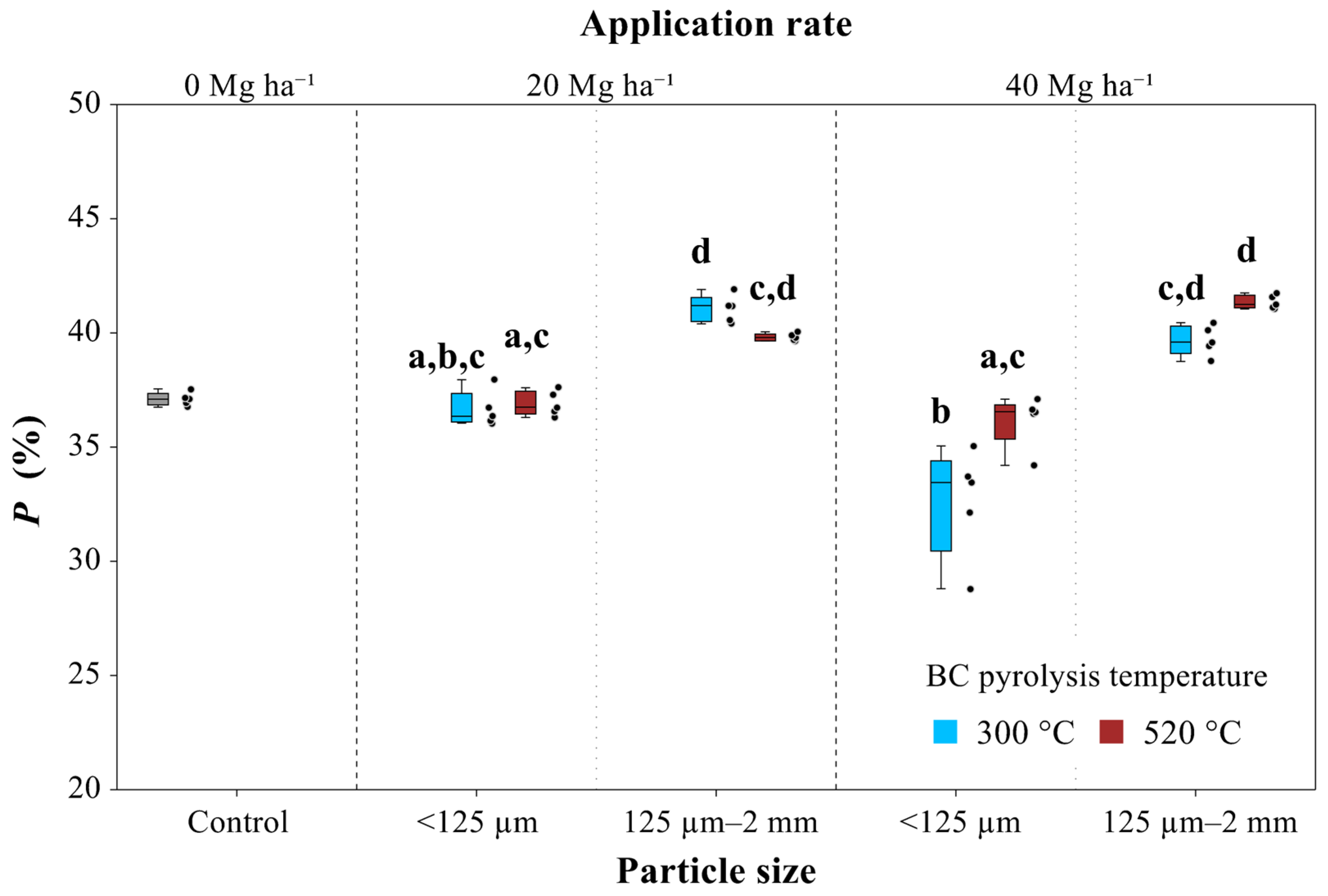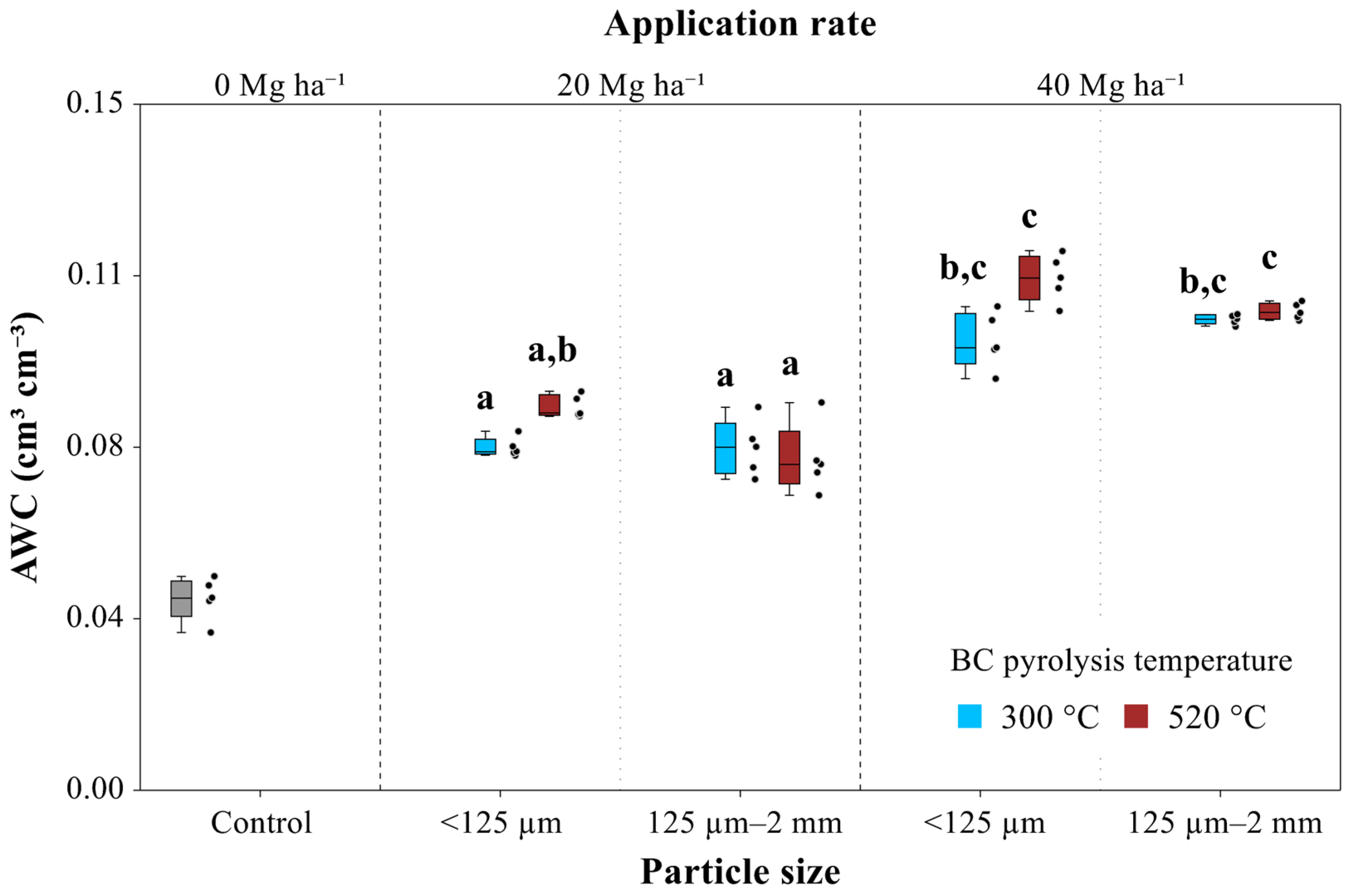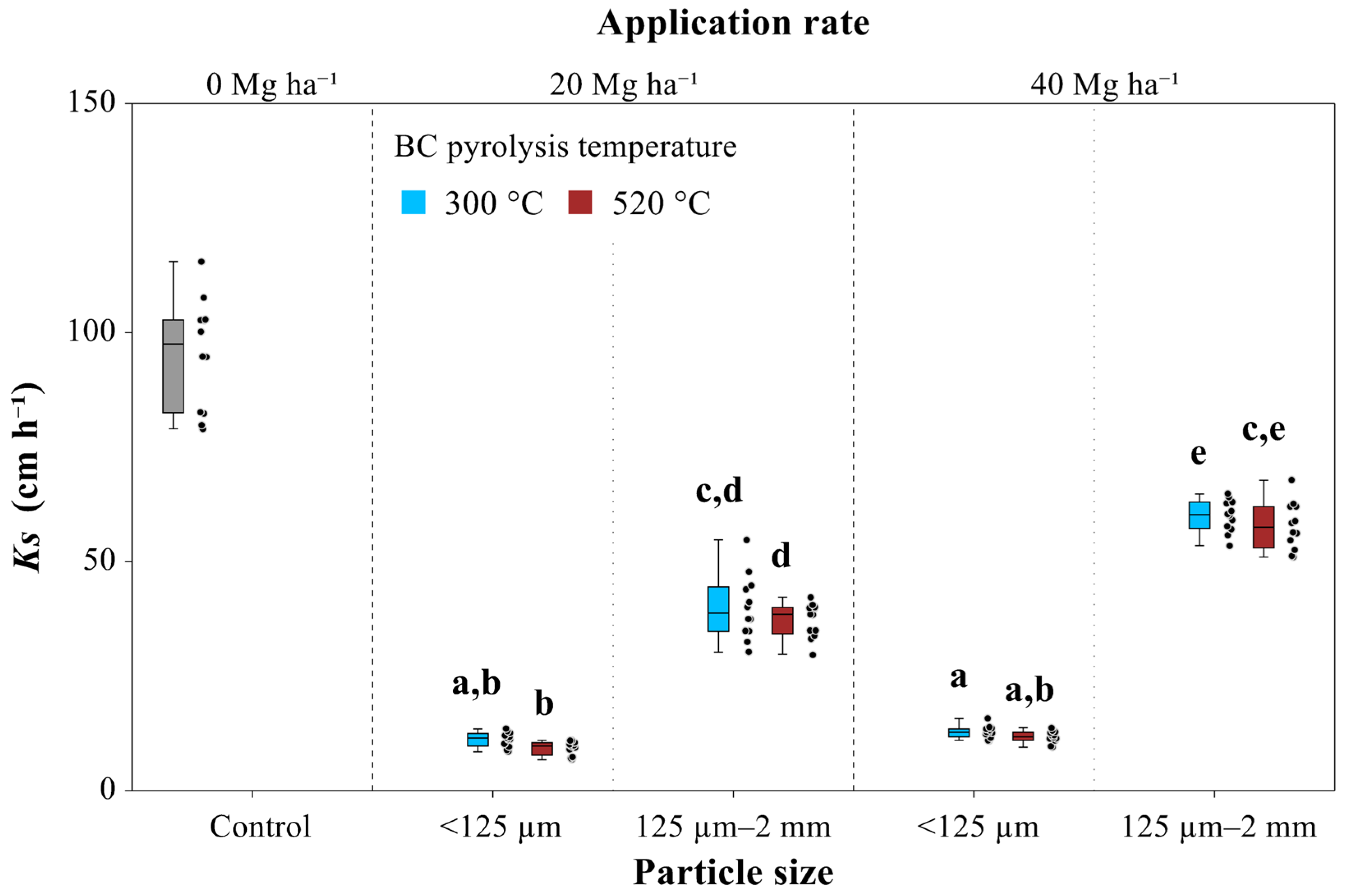Influence of Biochar Application Rate, Particle Size, and Pyrolysis Temperature on Hydrophysical Parameters of Sandy Soil
Abstract
:1. Introduction
2. Materials and Methods
2.1. Soil Description
2.2. Biochar Description
2.3. Experimental Design
2.4. Statistical Analyses
3. Results
3.1. Porosity
| Rate | Particle Size | PT | P (%) r = 5 | AWC (cm3 cm−3) r = 5 | KS (cm h−1) r = 12 | CA (°) r = 5 |
|---|---|---|---|---|---|---|
| 20 Mg ha−1 | <125 µm | 300 °C | 36.64 (0.78) | 0.075 (2 × 10−3) * | 11.19 (1.58) * | 64.82 (8.87) * |
| 20 Mg ha−1 | <125 µm | 520 °C | 36.90 (0.54) | 0.083 (2 × 10−3) * | 9.29 (1.44) * | 73.21 (9.81) * |
| 20 Mg ha−1 | 125 µm–2 mm | 300 °C | 41.05 (0.44) * | 0.074 (6 × 10−3) * | 40.01 (6.97) * | 54.43 (6.81) * |
| 20 Mg ha−1 | 125 µm–2 mm | 520 °C | 39.81 (0.16) * | 0.072 (8 × 10−3) | 37.17 (3.76) * | 56.83 (12.19) * |
| 40 Mg ha−1 | <125 µm | 300 °C | 32.62 (2.38) | 0.098 (6 × 10−3) * | 12.82 (1.35) * | 84.45 (6.91) * |
| 40 Mg ha−1 | <125 µm | 520 °C | 36.18 (1.13) | 0.112 (5 × 10−3) * | 11.77 (1.28) * | 91.04 (12.10) * |
| 40 Mg ha−1 | 125 µm–2 mm | 300 °C | 39.66 (0.64) * | 0.103 (1 × 10−3) * | 59.95 (3.48) * | 72.82 (20.35) * |
| 40 Mg ha−1 | 125 µm–2 mm | 520 °C | 41.34 (0.29) * | 0.105 (2 × 10−3) * | 57.82 (5.15) * | 77.94 (20.87) * |
| Control/sandy soil | 37.09 (0.28) | 0.042 (5 × 10−3) | 95.39 (12.01) | 15.44 (8.74) | ||
| Means for biochar rates | ||||||
| 20 Mg ha−1 | 38.60 (2.00) | 0.076 (7 × 10−3) | 24.41 (14.91) | 62.32 (11.62) | ||
| 40 Mg ha−1 | 37.45 (3.66) | 0.104 (6 × 10−3) | 35.59 (23.76) | 81.57 (16.40) | ||
| Means for biochar particle sizes | ||||||
| <125 µm | 35.59 (2.19) | 0.092 (1.5 × 10−2) | 11.27 (1.88) | 78.38 (13.60) | ||
| 125 µm–2 mm | 40.47 (0.87) | 0.088 (1.6 × 10−2) | 48.74 (11.42) | 65.50 (18.08) | ||
| Means for biochar pyrolysis temperatures | ||||||
| 300 °C | 37.49 (3.53) | 0.087 (1.3 × 10−2) | 30.99 (20.84) | 69.13 (15.83) | ||
| 520 °C | 38.56 (2.24) | 0.093 (1.6 × 10−2) | 29.01 (20.35) | 74.75 (18.21) | ||
| Soil Parameter | |||||||||
|---|---|---|---|---|---|---|---|---|---|
| P (%) | AWC (cm3 cm−3) | KS (cm h−1) | CA (°) | ||||||
| Factor | df | F | p | F | p | F | p | F | p |
| Pyrolysis temperature | 1 | 10.37 | 0.003 | 13.95 | 0.001 | 6.84 | 0.01 | 1.78 | 0.191 |
| Particle size | 1 | 217.42 | <0.001 | 5.84 | 0.021 | 2458.54 | <0.001 | 9.38 | 0.004 |
| Application rate | 1 | 12.01 | 0.002 | 364.48 | <0.001 | 218.66 | <0.001 | 20.96 | <0.001 |
| Temperature × size | 1 | 2.55 | 0.130 | 15.57 | <0.001 | 0.43 | 0.509 | 0.20 | 0.66 |
| Temperature × rate | 1 | 22.06 | <0.001 | 2.34 | 0.135 | 0.26 | 0.61 | 0.003 | 0.956 |
| Size × rate | 1 | 13.60 | 0.001 | 2.26 | 0.142 | 145.84 | <0.001 | 0.014 | 0.904 |
| Temperature × size × rate | 1 | 0.09 | 0.765 | 0.009 | 0.927 | 0.002 | 0.963 | 0.072 | 0.79 |




3.2. Available Water Content for Plants
3.3. Saturated Hydraulic Conductivity
3.4. Contact Angle
4. Discussion
5. Conclusions
Author Contributions
Funding
Data Availability Statement
Conflicts of Interest
References
- Baiamonte, G.; Crescimanno, G.; Parrino, F.; De Pasquale, C. Effect of Biochar on the Physical and Structural Properties of a Sandy Soil. Catena 2019, 175, 294–303. [Google Scholar] [CrossRef]
- Alghamdi, A.G.; Aljohani, B.H.; Aly, A.A. Impacts of Olive Waste-Derived Biochar on Hydro-Physical Properties of Sandy Soil. Sustainability 2021, 13, 5493. [Google Scholar] [CrossRef]
- Abel, S.; Peters, A.; Trinks, S.; Schonsky, H.; Facklam, M.; Wessolek, G. Impact of Biochar and Hydrochar Addition on Water Retention and Water Repellency of Sandy Soil. Geoderma 2013, 202–203, 183–191. [Google Scholar] [CrossRef]
- Edeh, I.G.; Mašek, O.; Buss, W. A Meta-Analysis on Biochar’s Effects on Soil Water Properties—New Insights and Future Research Challenges. Sci. Total Environ. 2020, 714, 136857. [Google Scholar] [CrossRef] [PubMed]
- Yang, Q.S.; Mašek, O.; Zhao, L.; Nan, H.Y.; Yu, S.T.; Yin, J.X.; Li, Z.P.; Cao, X.D. Country-Level Potential of Carbon Sequestration and Environmental Benefits by Utilizing Crop Residues for Biochar Implementation. Appl. Energy 2021, 282, 116275. [Google Scholar] [CrossRef]
- Quin, P.R.; Cowie, A.L.; Flavel, R.J.; Keen, B.P.; Macdonald, L.M.; Morris, S.G.; Singh, B.P.; Young, I.M.; Van Zwieten, L. Oil Mallee Biochar Improves Soil Structural Properties—A Study with x-Ray Micro-CT. Agric. Ecosyst. Environ. 2014, 191, 142–149. [Google Scholar] [CrossRef]
- Alotaibi, K.D.; Schoenau, J.J. Addition of Biochar to a Sandy Desert Soil: Effect on Crop Growth, Water Retention and Selected Properties. Agronomy 2019, 9, 327. [Google Scholar] [CrossRef]
- Ajayi, A.E.; Horn, R. Comparing the Potentials of Clay and Biochar in Improving Water Retention and Mechanical Resilience of Sandy Soil. Int. Agrophysics 2016, 30, 391–399. [Google Scholar] [CrossRef]
- Basso, A.S.; Miguez, F.E.; Laird, D.A.; Horton, R.; Westgate, M. Assessing Potential of Biochar for Increasing Water-Holding Capacity of Sandy Soils. Glob. Change Biol. Bioenergy 2013, 5, 132–143. [Google Scholar] [CrossRef]
- Vitková, J.; Kondrlová, E.; Rodný, M.; Šurda, P.; Horák, J. Analysis of Soil Water Content and Crop Yield after Biochar Application in Field Conditions. Plant Soil Environ. 2017, 63, 569–573. [Google Scholar] [CrossRef]
- Ndede, E.O.; Kurebito, S.; Idowu, O.; Tokunari, T.; Jindo, K. The Potential of Biochar to Enhance the Water Retention Properties of Sandy Agricultural Soils. Agronomy 2022, 12, 311. [Google Scholar] [CrossRef]
- Ajayi, A.E.; Horn, R. Modification of Chemical and Hydrophysical Properties of Two Texturally Differentiated Soils due to Varying Magnitudes of Added Biochar. Soil Till. Res. 2016, 164, 34–44. [Google Scholar] [CrossRef]
- Villagra-Mendoza, K.; Horn, R. Effect of Biochar Addition on Hydraulic Functions of Two Textural Soils. Geoderma 2018, 326, 88–95. [Google Scholar] [CrossRef]
- Fu, G.Q.; Qiu, X.N.; Xu, X.Y.; Zhang, W.; Zang, F.; Zhao, C.Y. The Role of Biochar Particle Size and Application Rate in Promoting the Hydraulic and Physical Properties of Sandy Desert Soil. Catena 2021, 207, 105607. [Google Scholar] [CrossRef]
- Xu, H.; Shan, Y.D.; Ling, N.; Ren, L.X.; Qu, H.G.; Liu, Z.P.; Xu, G.H. Divergent Effects of Food Waste Derived Hydrochar on Hydraulic Properties and Infiltration in a Sandy Soil. J. Hydrol. Part A 2023, 626, 130267. [Google Scholar] [CrossRef]
- Trifunovic, B.; Gonzales, H.B.; Ravi, S.; Sharratt, B.S.; Mohanty, S.K. Dynamic Effects of Biochar Concentration and Particle Size on Hydraulic Properties of Sand. Land Degrad. Dev. 2018, 29, 884–893. [Google Scholar] [CrossRef]
- Alessandrino, L.; Eusebi, A.L.; Aschonitis, V.; Mastrocicco, M.; Colombani, N. Variation of the Hydraulic Properties in Sandy Soils Induced by the Addition of Graphene and Classical Soil Improvers. J. Hydrol. Part C 2022, 612, 128256. [Google Scholar] [CrossRef]
- Liu, Z.P.; Ogunmokun, F.A.; Wallach, R. Does Biochar Affect Soil Wettability and Flow Pattern? Geoderma 2022, 417, 115826. [Google Scholar] [CrossRef]
- WRB. World Reference Base for Soil Resources 2014, Update 2015. In International Soil Classification System for Naming Soils and Creating Legends for Soil Maps, 4th ed.; International Union of Soil Sciences (IUSS): Vienna, Austria, 2022. [Google Scholar]
- ISO 10390; Soil, Treated Biowaste and Sludge. Determination of pH. International Organization for Standardization: Geneva, Switzerland, 2021.
- Walkley, A.; Black, I.A. An Examination of the Degtjareff Method for Determining Soil Organic Matter, and a Proposed Modification of the Chromic Acid Titration Method. Soil Sci. 1934, 37, 29–38. [Google Scholar] [CrossRef]
- Hraško, J. Soil Analyses, 1st ed.; Slovak Publishing House of Agricultural Literature: Bratislava, Slovakia, 1962; p. 335. (In Slovak) [Google Scholar]
- ISO 10523; Water Quality. Determination of pH. International Organization for Standardization: Geneva, Switzerland, 2008.
- Doerr, S.H. On Standardizing the “Water Drop Penetration Time” and the “Molarity of an Ethanol Droplet” Techniques to Classify Soil Hydrophobicity: A Case Study Using Medium Textured Soils. Earth Surf. Process. Landf. 1998, 23, 663–668. [Google Scholar] [CrossRef]
- Tinebra, I.; Alagna, V.; Iovino, M.; Bagarello, V. Comparing Different Application Procedures of the Water Drop Penetration Time Test to Assess Soil Water Repellency in a Fire Affected Sicilian Area. Catena 2019, 177, 41–48. [Google Scholar] [CrossRef]
- Danielson, R.E.; Sutherland, P.L. Porosity. In Methods of Soil Analysis: Part 1—Physical and Mineralogical Methods, 2nd ed.; Klute, A., Ed.; SSSA: Madison, WI, USA, 1986; pp. 443–461. [Google Scholar] [CrossRef]
- Blake, G.R.; Hartge, K.H. Particle density. In Methods of Soil Analysis: Part 1—Physical and Mineralogical Methods, 2nd ed.; Klute, A., Ed.; SSSA: Madison, WI, USA, 1986; pp. 377–381. [Google Scholar] [CrossRef]
- Jury, W.A.; Gardner, W.R.; Gardner, W.H. Soil Physics, 5th ed.; John Wiley and Sons: New York, NY, USA, 1991; p. 328. [Google Scholar]
- ISO 11274; Soil Quality. Determination of the Water-Retention Characteristic. Laboratory Methods. International Organization for Standardization: Geneva, Switzerland, 2019.
- van Genuchten, M.T. A Closed-Form Equation for Predicting the Hydraulic Conductivity of Unsaturated Soils. Soil Sci. Soc. Am. J. 1980, 44, 892–898. [Google Scholar] [CrossRef]
- Novák, V.; Hlaváčiková, H. Applied Soil Hydrology, 1st ed.; Springer: Cham, Switzerland, 2019; p. 342. [Google Scholar]
- Bachmann, J.; Horton, R.; van der Ploeg, R.R.; Woche, S. Modified Sessile Drop Method for Assessing Initial Soil-Water Contact Angle of Sandy Soil. Soil Sci. Soc. Am. J. 2000, 64, 564–567. [Google Scholar] [CrossRef]
- Goebel, M.O.; Woche, S.K.; Abraham, P.M.; Schaumann, G.E.; Bachmann, J. Water Repellency Enhances the Deposition of Negatively Charged Hydrophilic Colloids in a Water-Saturated Sand Matrix. Colloids Surf. A Physicochem. Eng. Asp. 2013, 431, 150–160. [Google Scholar] [CrossRef]
- Papierowska, E.; Matysiak, W.; Szatyłowicz, J.; Debaene, G.; Urbanek, E.; Kalisz, B.; Łachacz, A. Compatibility of Methods Used for Soil Water Repellency Determination for Organic and Organo-Mineral Soils. Geoderma 2018, 314, 221–231. [Google Scholar] [CrossRef]
- Gamage, D.N.; Mapa, R.B.; Dharmakeerthi, R.S.; Biswas, A. Effect of Rice Husk Biochar on Selected Soil Properties in Tropical Alfisols. Soil Res. 2016, 54, 302–310. [Google Scholar] [CrossRef]
- Głąb, T.; Palmowska, J.; Zaleski, T.; Gondek, K. Effect of biochar application on soil hydrological properties and physical quality of sandy soil. Geoderma 2016, 281, 11–20. [Google Scholar] [CrossRef]
- Głąb, T. Water retention and repellency of a sandy soil amended with municipal compost. Compost Sci. Util. 2014, 22, 47–56. [Google Scholar] [CrossRef]
- Verheijen, F.; Jefery, S.; Bastos, A.C.; Van der Velde, M.; Diafas, I. Biochar Application to Soils; A Critical Scientific Review of Effects on Soil Properties, Processes, and Functions; Office for Official Publications of the European Communities: Luxembourg, 2010; p. 166. [Google Scholar]
- Atkinson, C.J.; Fitzgerald, J.D.; Hipps, N.A. Potential Mechanisms for Achieving Agricultural Benefits from Biochar Application to Temperate Soils: A Review. Plant Soil 2010, 337, 1–18. [Google Scholar] [CrossRef]
- Novak, J.M.; Busscher, W.J.; Watts, D.W.; Amonette, J.E.; Ippolito, J.A.; Lima, I.M.; Gaskin, J.; Das, K.C.; Steiner, C.; Ahmedna, M.R.D.; et al. Biochars impact on soil-moisture storage in an Ultisol and two Aridisols. Soil Sci. 2012, 177, 310–320. [Google Scholar] [CrossRef]
- Gluba, Ł.; Rafalska-Przysucha, A.; Szewczak, K.; Łukowski, M.; Szlazak, R.; Vitková, J.; Kobyłecki, R.; Bis, Z.; Wichlinski, M.; Zarzycki, R.; et al. Effect of Fine Size-Fractionated Sunflower Husk Biochar on Water Retention Properties of Arable Sandy Soil. Materials 2021, 14, 1335. [Google Scholar] [CrossRef]
- Obia, A.; Mulder, J.; Martinsen, V.; Cornelissen, G.; Børresen, T. In Situ Effects of Biochar on Aggregation, Water Retention and Porosity in Light-Textured Tropical Soils. Soil Tillage Res. 2016, 155, 35–44. [Google Scholar] [CrossRef]
- Kinney, T.; Masiello, C.; Dugan, B.; Hockaday, W.; Dean, M.; Zygourakis, K.; Barnes, R. Hydrologic properties of biochars produced at different temperatures. Biomass Bioenergy 2012, 41, 34–43. [Google Scholar] [CrossRef]
- Peake, L.R.; Reid, G.J.; Tang, X. Quantifying the influence of biochar on the physical and hydrological properties of dissimilar soils. Geoderma 2014, 235–236, 182–190. [Google Scholar] [CrossRef]
- Uzoma, K.C.; Inoue, M.; Andry, H.; Zahoor, A.; Nishihara, E. Influence of Biochar Application on Sandy Soil Hydraulic Properties and Nutrient Retention. J. Food Agric. Environ. 2011, 9, 1137–1143. [Google Scholar]
- Liao, W.; Thomas, S.C. Biochar Particle Size and Post-Pyrolysis Mechanical Processing Afect Soil pH, Water Retention Capacity, and Plant Performance. Soil Syst. 2019, 3, 14. [Google Scholar] [CrossRef]
- Usowicz, B.; Lipiec, J.; Łukowski, M.; Marczewski, W.; Usowicz, J. The Effect of Biochar Application on Thermal Properties and Albedo of Loess Soil under Grassland and Fallow. Soil. Tillage Res. 2016, 164, 45–51. [Google Scholar] [CrossRef]
- Laird, D.A.; Fleming, P.; Davis, D.D.; Horton, R.; Wang, B.; Karlen, D.L. Impact of Biochar Amendments on the Quality of a Typical Midwestern Agricultural Soil. Geoderma 2010, 158, 443–449. [Google Scholar] [CrossRef]
- Brockhoff, S.R.; Christians, N.E.; Killorn, R.J.; Horton, R.; Davis, D.D. Physical and Mineral-Nutrition Properties of Sand-Based Turfgrass Root Zones Amended with Biochar. Agron. J. 2010, 102, 1627–1631. [Google Scholar] [CrossRef]
- Chen, C.; Wang, R.; Shang, J.; Liu, K.; Irshad, M.K.; Hu, K.; Arthur, E. Effect of Biochar Application on Hydraulic Properties of Sandy Soil under Dry and Wet Conditions. Vadose Zone J. 2018, 17, 1–8. [Google Scholar] [CrossRef]
- Lim, T.J.; Spokas, K.A.; Feyereisen, G.; Novak, J.M. Predicting the Impact of Biochar Additions on Soil Hydraulic Properties. Chemosphere 2016, 142, 136–144. [Google Scholar] [CrossRef] [PubMed]
- Hallin, I.L.; Douglas, P.; Doerr, S.H.; Bryant, R. The effect of addition of a wettable biochar on soil water repellency. Eur. J. Soil Sci. 2015, 66, 1063–1073. [Google Scholar] [CrossRef]
| Size Fraction (%) | pH (H2O) (-) | COX (%) | Carbonates (%) | ||
|---|---|---|---|---|---|
| Sand | Silt | Clay | |||
| 91.0 | 7.5 | 1.5 | 6.84 | 0.04 | <0.05 |
| Pyrolysis Temperature (°C) | pH (H2O) (-) | C (%) | H (%) | N (%) | WDPT (s) | CA (°) |
|---|---|---|---|---|---|---|
| 300 | 9.14 | 82.2 | 2.74 | 0.86 | 12,609 | 115.56 |
| 520 | 7.93 | 83.1 | 2.21 | 1.19 | 12,613 | 128.30 |
Disclaimer/Publisher’s Note: The statements, opinions and data contained in all publications are solely those of the individual author(s) and contributor(s) and not of MDPI and/or the editor(s). MDPI and/or the editor(s) disclaim responsibility for any injury to people or property resulting from any ideas, methods, instructions or products referred to in the content. |
© 2024 by the authors. Licensee MDPI, Basel, Switzerland. This article is an open access article distributed under the terms and conditions of the Creative Commons Attribution (CC BY) license (https://creativecommons.org/licenses/by/4.0/).
Share and Cite
Vitková, J.; Šurda, P.; Lichner, Ľ.; Výleta, R. Influence of Biochar Application Rate, Particle Size, and Pyrolysis Temperature on Hydrophysical Parameters of Sandy Soil. Appl. Sci. 2024, 14, 3472. https://doi.org/10.3390/app14083472
Vitková J, Šurda P, Lichner Ľ, Výleta R. Influence of Biochar Application Rate, Particle Size, and Pyrolysis Temperature on Hydrophysical Parameters of Sandy Soil. Applied Sciences. 2024; 14(8):3472. https://doi.org/10.3390/app14083472
Chicago/Turabian StyleVitková, Justína, Peter Šurda, Ľubomír Lichner, and Roman Výleta. 2024. "Influence of Biochar Application Rate, Particle Size, and Pyrolysis Temperature on Hydrophysical Parameters of Sandy Soil" Applied Sciences 14, no. 8: 3472. https://doi.org/10.3390/app14083472





